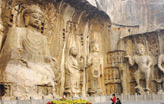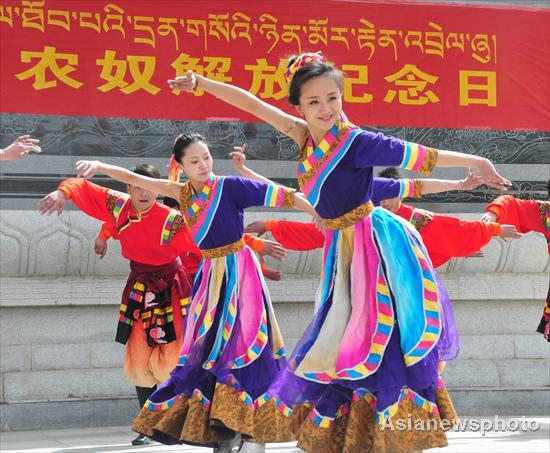Photos
Lhasa celebrates third annual Serfs Emancipation Day
Updated: 2011-03-29 06:46
By Hu Yongqi and Dachiong (China Daily)
LHASA - To spread the word about changes that have taken place in Tibet since the adoption of democratic reforms in 1959, the third Serfs Emancipation Day was celebrated on Monday throughout Lhasa, the capital of the autonomous region.
A ceremony celebrating Tibet's third Serfs Emancipation Day began on Monday in the square in front of the Potala Palace, a pilgrimage site for Tibetan Buddhists.
The ceremony was presented in both the Tibetan and Mandarin languages and attended by about 3,000 representatives of former serfs, soldiers from the People's Liberation Army and various others, including 800 students from the No 8 Middle School of Lhasa.
In 2009, the Tibet autonomous region's legislature designated March 28 as the annual Serfs Emancipation Day, marking the release of about 1 million people from serfdom in Tibet 52 years ago.
At 10 am, the Chinese national flag was raised against the background of the grand Potala Palace and of snow-capped mountains in the distance, while people in the square chanted the national anthem. Zhang Qingli, the Party chief of Tibet, attended the celebration, which lasted about half an hour.
Qin Yizhi, the Party chief of Lhasa, was the only official to deliver a speech. He said Lhasa has achieved great success in the past 52 years, noting the establishment of industries suited to Tibet's plateau environment and the ranking last year of Lhasa residents as the happiest in China.
"The democratic reforms started a new era for Tibet," Qin said.
"The Tibetan people are now able to put their destinies in their own hands. The autonomous region has perfectly implemented a policy granting freedom in religious belief and ensuring all Tibetan people enjoy such a right.
"From being an autocratic, backward and poverty-stricken plateau, the autonomous region has become a democratic, open and rich place.
"National unity and social stability will always be priorities for us, and we will keep making efforts toward ensuring economic prosperity and improving people's livelihoods."
Tashi Gyalpo, 82, living in Lhasa with four children who are doctors and soldiers, said his life is now better than "the landlord's was in the past".
In former times, he had seen serfs wailing and begging for handouts from passers-by. The legs, hands and eyes of some had been cut off or out, he said.
The landlords he had seen, meanwhile, had worn luxurious dress.
Some even rode on the backs of their serfs, he said.
After the reforms, former serfs no longer had to follow the orders of landlords and gained the freedom to decide what they wanted to do with themselves.
"My grandparents were both serfs," said Tenzin Lodro, 13, a junior student at Lhasa No 8 Middle School.
Although she did not have the same experiences as her grandparents had, she was eager to learn about Tibet's history. So, in the past two years, she has taken the time to watch dozens of movies about serfs' lives.
"Students are subsidized by the government so we can learn more," she said. "Life now is much better in Tibet, and we should cherish the hard-earned fruits of our labors."
Celebrations were also held at the Zhaibung Monastery, one of the largest Tibetan Buddhist monasteries in Lhasa. Ngawang Chodrak, a monk at the monastery, said the monastery has been restored and improved.
"We monks will continue working to unite the Tibetan people and contribute to the social development of Tibet."
China Daily
Specials

Tea-ing up
More turning to Chinese tea for investment opportunities like vintage wine

A cut above
The ancient city of Luoyang is home to a treasure trove of cultural wonders.

Rise and shine
The Chinese solar energy industry is heating up following recent setbacks in the nuclear sector

